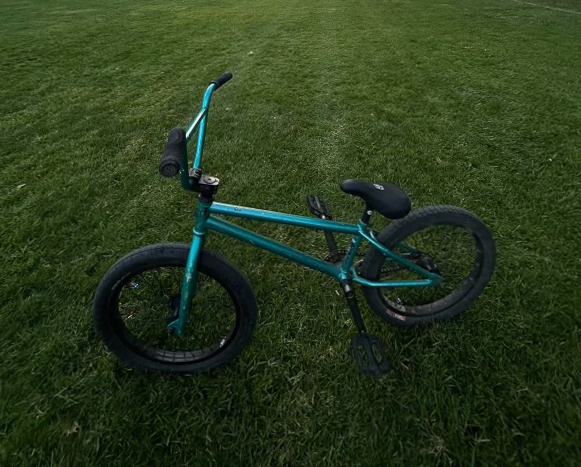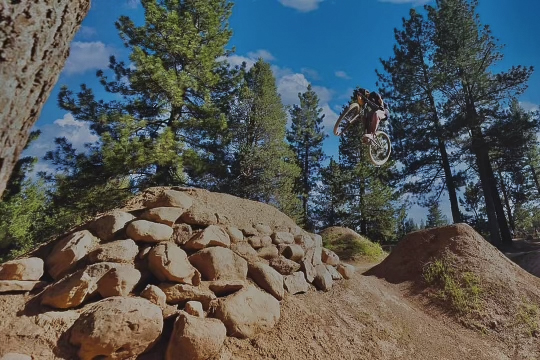Freshman Cameron Polidoro started his journey in biking at 4 years old. With the support of his family, Polidoro was constantly encouraged to become a biker and try sports outside of his comfort zone.
“My dad grew up in the motorcycle industry and because of that, for my first bike, he didn’t want me to get just a normal bike,” Polidoro said. “We got something cool because he knew I was going to thrash it around so he got me a BMX bike.”

After getting the BMX when he was 9 years old, he’s been a regular participant in the mountain biking community. Despite mountain bikers like Polidoro and junior Edison Costa’s love for the sport, they both agree that mountain biking can be a dangerous sport and often leads to injury.
“There are a lot of things that can go wrong,” Costa said. “And most of the time when you’re mountain biking, there’s not always people around to help you in case you crash.”
Junior Darren Lin started mountain biking during his freshman year and says that he also has personal experience with crashing on trails, adding that he occasionally had to take short breaks from riding while recovering from an injury.
“I overestimated my skill and I didn’t have proper control of my bike,” Lin said. “I went over the bars and I dislocated my left shoulder and I scraped everything and my chin as well. I had to sit out on my couch for a month and it was really off putting.”
Similarly, Polidoro injured his spine performing a 25 foot gap jump, a jump where riders jump from one obstacle to another that is 25 feet away, which caused him to have to go to four months of physical therapy and sit out of biking for a year. Polidoro agrees with Lin, saying that recovering from his injury was not only challenging physically but also emotionally.
“When you get something taken away from you that you love, it’s really hard and that was my first big injury that I had,” Polidoro said. “I didn’t realize how much I loved the sport until that happened. I would be sitting on my bed every day just watching car videos or something. And I’m like, ‘Wow, this really sucks.’ It was my first taste of how bad it sucks to get something taken away from you like that.”
While Lin’s injury to his shoulder and chin after he went over his handlebars wasn’t as severe as Polidoro’s, he agrees that his injury had a psychological effect on him when he finally made his return to mountain biking.
“I was really scared the first couple weeks,” Lin said. “I was going really, really slow and I just doubted myself and my own skills. I think as I progressed and I actually went back to the fundamentals, it gave me more confidence and took those views away.”
Although getting injured can be disheartening, Polidoro believes that getting hurt is bound to happen. However, Lin says the risk of injury is easily avoidable if you stay in your skill level and continue to practice. Costa agrees that mountain biking becomes a safer sport as you continue to progress, keeping in mind the limits of the trail and your bike.

“If you focus on the fundamentals and make sure that you have the right skills to make sure that you can avoid crashes, it’s not that dangerous,” Lin said. “After I started practicing, I never crashed again.”
Injuries are apparent in all sports, especially mountain biking. According to a study by Michael R. Carmont on mountain biking injuries, “The overall injury rate is 16.8 injuries per 1000 h exposures.” Despite their injuries, Lin, Polidoro and Costa agree that they will continue mountain biking and working on their skills.
“I think it’s always a dangerous sport but if you want to be in the sport, you kind of just have to accept that it happens,” Polidoro said. “And I mean, even though it happened, I mean it sucks and it’s scary. But, at the end of the day, that’s just a consequence that everyone has to face.”
Even though Polidoro recognizes the possibility of getting seriously injured when he goes mountain biking, he says that he will continue to mountain bike because of his love for the sport.
“I had been resisting to do this big, big line, the one that I crushed on,” Polidoro said. “It starts with a 25 footer and then a 15 footer. And I remember my friend was hitting it one day and I was kinda like, ‘Come on, hit that,’ but I never hit it. And then one day I just went out there with him and we just looked at it together and I hit it and that was probably one of the best days of my life.”












